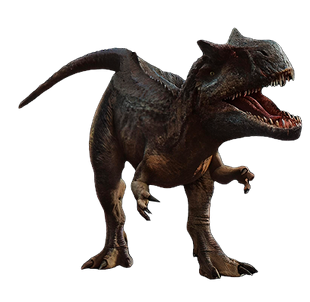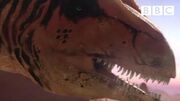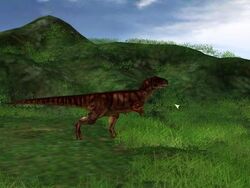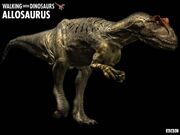
Allosaurus (March, 1877) meaning, "different, other-lizard", was one of the largest Jurassic predators known, growing in average up to 28 feet (8.5 meters) while larger animals could grow up to 32 feet (9.7 meters). It had a large skull with eye ridges, and claws designed for gripping. It ate many different dinosaurs, such as the Dryosaurus, the stegosaurid Stegosaurus, and even young sauropods like Diplodocus and Apatosaurus. Due to its large size and 'new-age' design, the previous apex Jurassic predator Ceratosaurus was very hard competition since it was around the same size, but Allosaurus itself had to deal with harder competition from a large megalosaurid named Torvosaurus as well as the similar-sized Megalosaurus. Saurophaganax is a larger allosaurid genus that grew up to 39 feet (12 meters). One particularly well-preserved specimen, nicknamed "Big Al", was found not too long ago in Wyoming. While Allosaurus was a hunter, it was also a scavenger. It would find dead animals or animals dying to feast on. "Big Al" had many different injuries from throughout its short, seven year life, yet surviving all but the last one, an infected toe wound. This would have left the animal unable to hunt, and it would have starved or died of thirst.
Description[]
Allosaurus stood about 15 feet tall and measured about 28 feet though some remains suggest it could reach over 11.8 meters (39 ft) depending on which genus it is. Its three-fingered forelimbs were smaller than its large hind legs, and the body was balanced by a long, heavy tail.[1] It weighed 2-3 tons. The skull was narrow and had a pair of horns above and in front of the eyes.[2]
Classification[]
There are five recognised species of Allosaurus:
- A. fragilis
- A. tendagurensis
- A. atrox
- A. europaeus
- A. jimmadseni
- Saurophaganax. maximus (possibly an Allosaurus)
- Epanterias. amplexus (originally Allosaurus. amplexus)
- Antrodemus. valens (possibly an Allosaurus)
History[]
It was first discovered in 1869 by Ferdinand Hayden and then named in 1877 by its founder Othniel Marsh.
Remains of many individuals have been found, including some which are almost complete. Over 60 individuals from one species have been found.[3]
Paleobiology[]
Feeding[]
Sauropods, live or dead, seem to be likely candidates as prey. Sauropod bones with holes fitting allosaur teeth, and the presence of shed allosaur teeth with sauropod bones have been found.[4]
There is dramatic evidence for allosaur attacks on Stegosaurus. An Allosaurus tail vertebra has been found with a partially healed puncture which fits a Stegosaurus tail spike. Also, there is a Stegosaurus neck plate with a U-shaped wound that correlates well with an Allosaurus snout.[5]
Allosaurus was probably not a predator of fully grown sauropods, unless it hunted in packs. It had a modestly sized skull and relatively small teeth, and was greatly outweighed by adult sauropods. Another possibility is that it preferred to hunt juveniles instead of fully grown adults.
Researchers have made other suggestions. Robert T. Bakker compared the short teeth to serrations on a saw. This saw-like cutting edge runs the length of the upper jaw, and could have been driven into prey. This type of jaw would permit slashing attacks against much larger prey, with the goal of weakening the victim.[6]
Another study showed the skull was very strong but had a relatively small bite force. The authors suggested that Allosaurus used its skull like a hatchet against prey, attacking open-mouthed, slashing flesh with its teeth, and tearing it away without splintering bones.
They suggested that different strategies could be used against different prey. The skull was light enough to allow attacks on smaller and more agile ornithopods, but strong enough for high-impact ambush attacks against larger prey like stegosaurs and sauropods.[7]
Their ideas were challenged by other researchers, who found no modern examples of a hatchet attack. They thought it more likely that the skull was strong to absorb stresses from struggling prey.[8]
The original authors noted that Allosaurus itself has no modern equivalent, so the absence of a modern 'hatchet attacker' was not significant. They thought the tooth row was well-suited to such an attack, and that articulations (joints) in the skull helped to lessen stress.[9]
Another possibility for handling large prey is that theropods like Allosaurus were 'flesh grazers' which could take bites of flesh out of living sauropods, sufficient to sustain the predator so it did not need to kill the prey outright. This strategy might have allowed the prey to recover and be fed upon again later.[10]
Another idea is that ornithopods, the most common available prey, could be subdued by Allosaurus grasping the prey with their forelimbs, and then making bites on the throat to crush the trachea.[11] The forelimbs were strong and capable of restraining prey,[12] and the articulation of the claws suggests that they could have been used to hook things.[13]
The shape of the Allosaurus skull limited binocular vision to 20° of width, slightly less than that of modern crocodilians. As with crocodiles, this may have been enough to judge prey distance and time attacks.[14] The similar width of their field of view suggests that allosaurs, like modern crocodiles, were ambush hunters.[15]
Finally, the top speed of Allosaurus has been estimated at 30 to 55 kilometers per hour (19 to 34 miles per hour).[16]
Social behavior[]
Some paleontologists think Allosaurus had cooperative behavior, and hunted in packs. Others believe they may have been aggressive toward each other.
Groups have been found together in the fossil record. This might be evidence of pack behavior, or just the result of lone individuals feeding on the same carcass.
In the Media[]
Allosaurus has appeared multiple times in the famous Walking With Dinosaurs series. It was featured in the special, The Ballad of Big Al.
Allosaurus has been featured in three episodes of the History Channel series Jurassic Fight Club fighting two Ceratosaurus as three Allosaurus attack a Stegosaurus, however one gets killed as a herd of Camarasaurus come to drink the water but one gets stuck, as it gets the Allosaurus's attention.
Allosaurus can also be found in the Dinosaur Digs expansion pack for the popular PC game, Zoo Tycoon.
Allosaurus is also on a list of animals supossedly to be in the fourth Jurassic Park movie, however it wasn't confirmed, until it appeared in Jurassic World: Fallen Kingdom.
Allosaurus has also been featured in the Jurassic Park park-builder sim Operation Genesis.
Allosaurus from Dinosaur Revolution
Allosaurus appears in the game Dino Crisis 2 as a mid-game rival and in the arena as a fighter. Allosaurus also appears in Dinosaur King and Dino Master.
It appears in Dinosaur Revolution. The main Allosaurus in the show has its jaw broken by the tail of a Dinheirosaurus. It also was shown to attack a Torvosaurus despite the size difference.

A deadly Allosaurus ambushes its prey Planet Dinosaur - BBC
Allosaurus appears in Planet Dinosaur where it fails on its first hunt for a Stegosaurus. It later kills a Camptosaurus, but unfortunately a Saurophaganax steals its prey.
Allosaurus has only appeared in The Land Before Time VI: the Secret of Saurus Rock, where she serves as the main antagonist of the film.
In the cartoon The Terrible Thunderlizards, Squat is an Allosaurus.
In the Manga/Anime One Piece the Allosaurus appears as a Devil Fruit as the Ryu Ryu no Mi/Dragon-Dragon Fruit, Model: Allosaurus.

An Allosaurus in Jurassic Park: Operation Genesis

Allosaurus as depicted in Walking with Dinosaurs
See Also[]
References[]
Template:References
External links[]
- Specimens, discussion, and references pertaining to Allosaurus at The Theropod Database.
- Allosaurus at DinoData.
- Utah State Fossil, Allosaurus, from Pioneer: Utah's Online Library.
- Restoration of MOR 693 ("Big Al") and muscle and organ restoration at Scott Hartman's Skeletal Drawing website.
- List of the many possible Allosaurus species...
- ↑ Madsen, James H, Jr. 1993 [1976]. Allosaurus fragilis: a revised osteology. 2nd ed, Utah Geological Survey Bulletin 109. Salt Lake City: Utah Geological Survey.
- ↑ Madsen, James H., Jr. (1993) [1976]. Allosaurus fragilis: A Revised Osteology. Utah Geological Survey Bulletin 109 (2nd ed.). Salt Lake City: Utah Geological Survey.
- ↑ Holtz, Thomas R., Jr.; Molnar, Ralph E.; and Currie, Philip J. 2004. Weishampel, David B.; Dodson, Peter; and Osmólska, Halszka (eds) The Dinosauria. 2nd ed, Berkeley: University of California Press. pp. 71–110. ISBN 0-520-24209-2
- ↑ Fastovsky, David E.; and Smith, Joshua B. 2004. "Dinosaur Paleoecology", in The Dinosauria, 2nd ed. 614–626.
- ↑ Template:Cite book
- ↑ Template:Cite journal
- ↑ Template:Cite journal
- ↑ Template:Cite journal
- ↑ Template:Cite journal
- ↑ Holtz, Thomas R., Jr.; Molnar, Ralph E.; and Currie, Philip J. 2004. Weishampel, David B.; Dodson, Peter; and Osmólska, Halszka (eds) The Dinosauria. 2nd ed, Berkeley: University of California Press. pp. 71–110. ISBN 0-520-24209-2
- ↑ Foster, John Wikipedia:2007. "Allosaurus fragilis". Jurassic West: the dinosaurs of the Morrison Formation and their world. Bloomington, Indiana: Indiana University Press. pp. 170–176. ISBN 978-0-253-34870-8 OCLC 77830875
- ↑ Carpenter, Kenneth 2002. "Forelimb biomechanics of nonavian theropod dinosaurs in predation". Senckebergiana lethaea 82 (1): 59–76. doi:10.1007/BF03043773
- ↑ Gilmore, Charles W. 1920. "Osteology of the carnivorous dinosauria in the United States National Museum, with special reference to the genera Antrodemus (Allosaurus) and Ceratosaurus". Bulletin of the United States National Museum 110: 1–159.
- ↑ Template:Cite journal
- ↑ "Evolve: Eyes". History channel Evolve. Transcript.
- ↑ Template:Cite journal